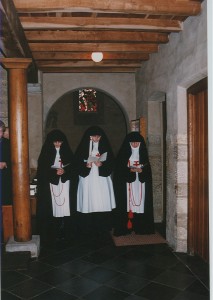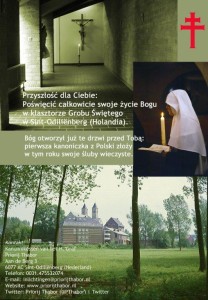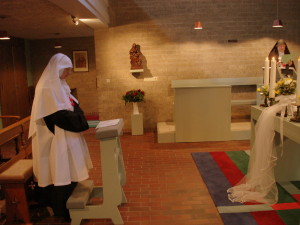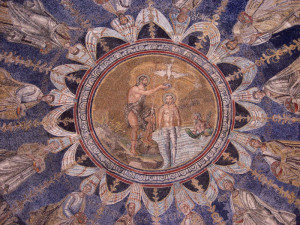Voert God Uw levensweg naar ons klooster?
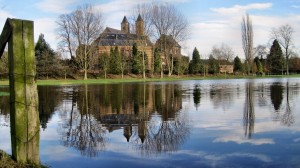
Wie zijn wij?
De Kanunnikessen van het Heilig Graf die in Priorij Thabor wonen zijn een Rooms Katholieke religieuze gemeenschap. De liefde tot God en de medemensen staat centraal in hun leven in navolging van Christus, gestorven en verrezen. De liefde van God voor de mensheid beantwoorden zij door zich gedurende de dag vaak tot God te wenden in liturgisch en persoonlijk gebed om Hem te danken voor de schepping en de instandhouding ervan en voor Zijn liefde tot iedere mens afzonderlijk. In het bewustzijn dat Jezus Christus, de Zoon van God, de mensheid heeft verlost van zonde en dood, en dat Jezus ons God heeft getoond, willen de zusters Jezus’ leven, lijden en sterven en verrijzen uit de dood steeds in hun gebed overwegen en Jezus navolgen in het dagelijkse leven. Evangelisch leven betekent voor hen bidden namens de wereld en voor de wereld en naar vermogen klaar staan voor al degenen die beroep doen op hun hulp.
Sacrale plaats
Sint Odiliënberg, vroeger Sint Petrusberg geheten, ligt als een kostbaar kleinood aan het kronkelende riviertje de Roer in de meest zuidelijke provincie van Nederland. De grijze kerkberg met de bescheiden Romaanse doopkapel, gewijd aan de Moeder Gods, en de door twee ranke torens gemarkeerde basiliek vormen een schilderijtje apart. Op de achtergrond ziet men de Priorij van het H. Graf.
Tussen de doopkapel in het noorden en het klooster van het H. Graf in het zuiden, spanningsvolle polen van geboorte, dood en verrijzenis, verheft zich de basiliek als een monumenale gestalte van het volle, op het evangelie gebouwde en in het geloof bevestigde leven. Talrijk zijn de heiligen, die in dit godshuis worden vereerd. Hun beelden en symbolen houden de spirituele geschiedenis van de oude en vermaarde Kerkberg aan de Roer levend tot op de dag van vandaag.
Op de kruin van de eeuwenoude Berg getuigt bijna alles van godgewijd leven. Kinderen worden er gedoopt, huwelijken gesloten, de evangelische raden beoefend, biecht gehoord, moedelozen getroost, gebeden gestort en doden begraven. Bovenal ruist in de gewijde ruimten en over berg en landerijen de blijdschap van het Alleluia, de vreugde van het Credo en de vreugdevolle voltooiing van het Ite, missa est. De vertroosting van het Eucharistische Geheim verleent aan het leven op de Berg de stille glans van de eeuwigheid, waar hemel en aarde elkaar raken.
Deze plaats werd in de 8e eeuw door een van de Frankische Pippijnen, het voorgeslacht van Karel de Grote (768-814) geschonken aan de Angelsaksische, later heilig verklaarde, monniken Wiro, Plechelmus en Otger als thuisbasis voor hun missioneringswerk in de streken tussen Maas en Rijn.
Hier vond ook in de 9e eeuw de bisschop van Utrecht met zijn kanunnikenkapittel een veilig oord op de vlucht voor de Noormannen. In de 15e eeuw werd deze Berg aan de Kanonikale Orde van het H. Graf geschonken “om er een regulier vrouwenklooster op te richten”. Hier legde de priester-kanunnik Jan van Abroeck, die zich wars van alle comfort en wereldse praal met hart en ziel inzette voor de idealen van de Orde van het H. Graf, de basis voor de vrouwenkloosters van het H. Graf die zich in de komende eeuwen over West-Europa zouden verspreiden. Zijn leuze was: Gods wil en eer.
In 1888 werd de oude monastieke traditie op de Berg tot nieuw leven gebracht en tot op heden woont en leeft een kleine communiteit van kanunnikessen van de Orde van het H. Graf op de kerkberg aan de Roer in een klooster, dat de naam Priorij Thabor draagt. Ook de wereldlijke overheid in Nederland erkent de grote cultuurhistorische waarde van de Berg. Berg, kerk, klooster en pastorie worden gezamenlijk gekwalificeerd en beschermd als Rijksmonument en zijn in 2015 grootschalig gerestaureerd.
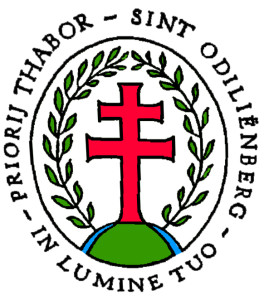
Oorsprong van de Orde
Onder de kanonikale Orden van kanunniken en kanunnikessen onderscheidt de Orde der Reguliere Kanunnikessen van het H. Graf zich door haar grote betrokkenheid bij het H. Graf des Heren in de Verrijzenisbasiliek te Jeruzalem, waarmee zij zich door historische en spirituele banden nauw verbonden weet. De kanonikale Orde van het Heilige Graf is een kloosterorde en dient te worden onderscheiden van de Ridderorde van het Heilig Graf, die veel later is ingesteld en een lekenorde is.
De kanunnikessen van het Heilig Graf zijn de geestelijke erfgenamen van het Latijnse kanunniken-kapittel dat in 1099, na de inneming van Jeruzalem door Godfried van Bouillon ten tijde van de Eerste Kruistocht, de bediening van de H. Grafkerk kreeg toegewezen om er de liturgische plechtigheden te verzorgen: de H. Eucharistie te vieren en als bijzondere opdracht de Getijden te zingen volgens de Latijnse ritus.
Dit kapittel nam in 1114, onder invloed van de kerkelijke vernieuwingsbeweging, bekend als Gregoriaanse hervorming, de Regel van de H. Augustinus aan, om voortaan als kloostergemeenschap in gemeenschap van goederen te gaan leven. Zij stippelden hun leefregel verder uit volgens eigen Constituties. In 1122 werd de Sepulcrijnerorde door Paus Callixtus II erkend als Orde van de Reguliere Kanunniken van het Heilig Graf te Jeruzalem. De kanunniken herstelden de bouwvallige kerk van het H Graf en droegen zorg voor het bewaren van de H. Plaatsen in het H. Land. Ook onderrichtten zij kinderen in godsdienstige en liturgische gebruiken, namen pelgrims op, stonden de armen bij en onderwezen hen in de waarheden van het geloof.
Paus Johannes-Paulus II bezocht op 26 maart 2000 de H. Grafkerk in Jeruzalem en zei toen in zijn homilie: “Hier in de kerk van het H. Graf is het Heilig Graf leeg. Het is een zwijgend getuigenis van de centrale gebeurtenis van heel de mensengeschiedenis: de Verrijzenis van onze Heer Jezus Christus. Bijna tweeduizend jaar lang heeft het lege graf getuigenis afgelegd van de overwinning van het Leven op de dood. De Verrijzenis van onze Heer Jezus Christus is het teken dat de eeuwige Vader trouw is aan zijn belofte en nieuw leven uit de dood doet opstaan.”
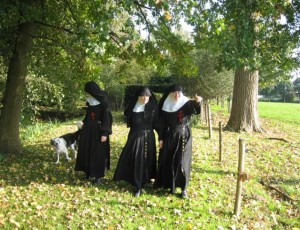 Kloosterleven in Sint Odiliënberg nu
Kloosterleven in Sint Odiliënberg nu
De oude spiritualiteit van het H. Graf leeft in Sint Odiliënberg tot op de dag van vandaag. Door de dagelijkse viering van de liturgische Getijden (lauden, lezingendienst, terts, sext, noon, vespers en completen) beantwoorden de kanunnikessen aan het eerste doel van hun Orde: God loven voor de weldaad van de verlossing en de glorie van de Verrijzenis van de Heer bezingen. Door dit kloosterideaal maar ook door ijverige toeleg op de bekering van het hart tot God worden het apostolisch leven, de activiteiten en de dienst aan de medemens gedragen.
In onze tijd – waarin enerzijds God uit de gedachte van de mensen wordt verbannen en waarin anderzijds de mensen snakken naar verlossing uit een zinloos bestaan en naar blijvend geluk, dat alleen in God te vinden is – is het getuigenis van deze spiritualiteit zeer waardevol, zeker in het geseculariseerde West-Europa. Het PAASMYSTERIE, hoogtepunt van alle Liturgie, staat immers centraal in het kanonikale leven van de Orde.
Deze ordesspiritualiteit sluit nauw aan bij de algemeen kerkelijke spiritualiteit zoals ook het 2e Vaticaans Concilie het uitdrukt in de Constitutie over de H. Liturgie. Zonder ophouden komen ook wij dagelijks bijeen voor de viering van het Paasmysterie om te lezen wat in al de Schriften op Christus betrekking heeft, om de Eucharistie te vieren waarin de overwinning en triomf van zijn dood tegenwoordig worden gesteld, en tevens in Christus God dank te brengen voor zijn onuitsprekelijke gaven tot lof van zijn heerlijkheid door de kracht van de H. Geest. (Vgl. Sacrosanctum Concilium nr. 5).
Zoals de H. Eucharistie het hart is van het kerkelijke leven, is zij dat ook van het godgewijde leven. Zij is de dagelijkse teerspijs en de bron van spiritualiteit. Door middel van de Eucharistie wordt iedere godgewijde mens uitgenodigd om Christus’ Paasmysterie te beleven en zich met Hem te verenigen door zijn eigen leven door de Heilige Geest aan de Vader op te dragen. Zo wordt het leven van de religieuze een voortdurende eredienst aan God in liefde.
Onverbrekelijk hiermee verbonden is Christus’ gebod van de naastenliefde “die ons wordt geschonken door Dezelfde, die zegt: Zoals Ik u bemind heb, moet ook gij elkaar beminnen. Door ons te beminnen schonk Hij ons dit: dat wij door een onderlinge liefdeband verenigd zouden zijn en wij door die zo zachte band van onderlinge liefde tussen de ledematen het lichaam zouden vormen van zulk een Hoofd”. (vgl. H. Augustinus, Tractaat 65,3 op het Johannesevangelie)
Zoals de Apostelen op de berg THABOR verblijd en gesterkt werden door het aanschouwen van de heerlijkheid des Heren, om trouw te kunnen blijven in het zwaarste lijden, zo vinden ook de H. Grafzusters van de priorij Thabor op de kerkberg hun vreugde en kracht in de aanwezigheid van de Verrezen Christus in de Liturgie van de Kerk en de eucharistische aanbidding.
De Liturgie inspireert bovendien tot een leven van eensgezindheid (christelijk leven = gemeenschapsleven), persoonlijk gebed en inzet voor de naaste. Van heinde en verre komen kinderen en volwassenen naar het klooster voor geloofsonderricht, bij de voorbereiding op Sacramenten maar ook als zij Rooms Katholiek willen worden.
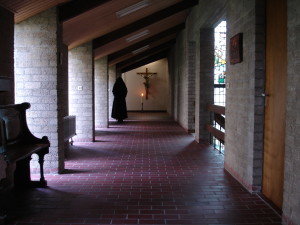 De blik gericht op de toekomst
De blik gericht op de toekomst
De communiteit is autonoom met na Vaticanum II goedgekeurde Constituties, maar is op dit moment zeer klein geworden. Ondanks het geringe aantal religieuzen (7) streven we er met alle krachten naar het godgewijde leven in zijn kleine en grote consequenties te beleven niet alleen uitgedrukt o.a. door het dragen van het religieuze kleed, het onderhouden van het pauselijk slot en het bewaren van de tradities van de Orde, maar ook in de trouw aan de Romeinse Liturgie (Latijn en Gregoriaanse zang) in volle verbondenheid met en gehoorzaamheid aan de Kerk en de Paus.
Wij hopen en bidden dat er degelijke dames door Onze Lieve Heer geroepen worden om ons klooster te komen versterken, zodat wij ook in de komende tijden kunnen doorgaan de schatten van onze rijke tradities door te geven tot lof van Christus en zijn Kerk en tot heil van onze medemensen (vgl. Sacrosanctum Concilium nr. 7).
Een van onze zusters schreef over haar roepingsgeschiedenis op onze weblog:
Ik werd mij bewust dat God hier in dit klooster het grote middelpunt was. Het was een openbaring voor mij en ook het Latijn vormde geen enkele belemmering ook al leek het aanvankelijk Chinees! Tranen rolden stiekem over mijn wangen. ’s Avonds bij de Completen werd de respons “In manus tuas, Domine, commendo spiritum meum” – In uw handen, Heer, beveel ik mijn geest- gezongen, en dat gaf de doorslag, dít was het. De zekerheid die God mij toen gaf, kan ik niet met woorden beschrijven, maar wel wist ik vanaf dat moment en nu nog steeds: Sint-Odiliënberg is mijn droom. Dit klooster is mijn thuis.
Heel graag verwelkomen wij jonge(re) dames / meisjes die zich willen oriënteren op de vraag of onze levensweg ook voor hen de weg ten leven is waartoe zij voor Christus worden geroepen. Andere talen dan Nederlands zijn geen probleem. We spreken Nederlands, Duits, Frans en Engels en onze jongste zuster komt uit Polen. Zij spreekt daarnaast ook Russisch.
Informatie:
Reguliere Kanunnikessen van het H. Graf
Zuster M. Jacqueline
Priorij Thabor
Aan de Berg 3
NL 6077 AC Sint Odiliënberg
Tel. 0031 (0) 475 532074
E-mail: zr.jacqueline@priorijthabor.nl
Website: www.priorijthabor.nl
Weblog: priorijthabor.blogspot.com
Twitter: @PThabor


